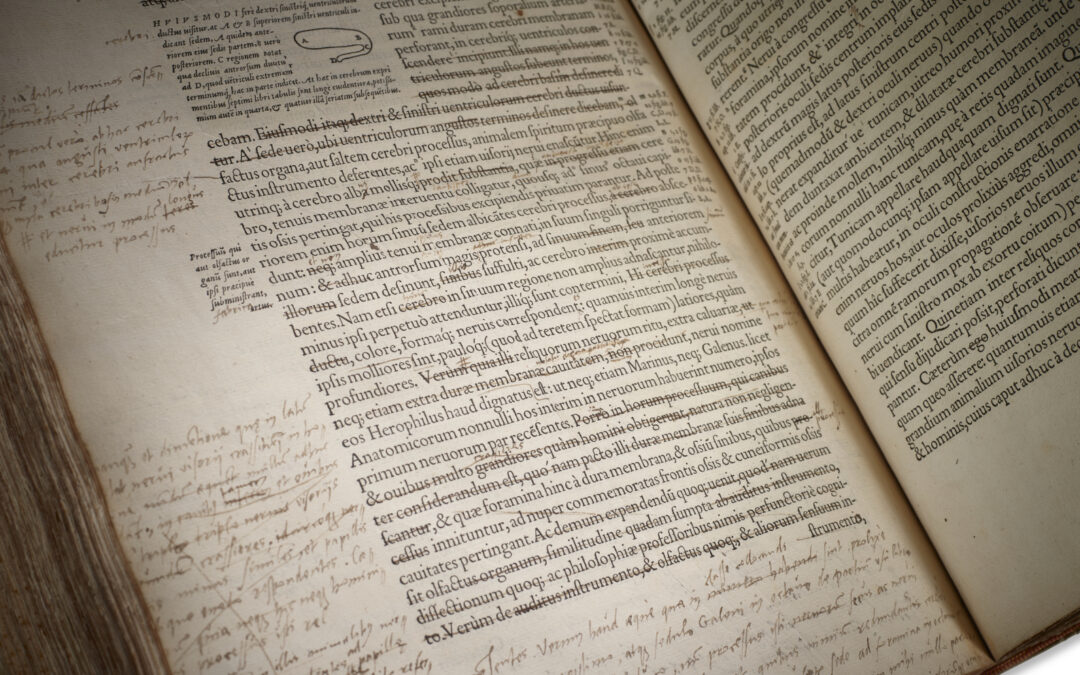Photo: © 2024 Christie’s Images Limited.
Copies of Andreas Vesalius’s revolutionary textbook of anatomy, De humani corporis fabrica (“The Structure of the Human Body”), are scattered around the world in libraries and private collections. An intrepid team of Vesalius scholars has compiled a global census of the Fabrica, as it’s known, and as of 2020 they’d hunted down 308 copies of the 1543 first edition, and 422 copies of the 1555 second edition.
There’s no third edition – but that’s what makes one particular copy of the second edition so special. Any Fabrica in reasonable condition coming on the market these days would surely command a six-figure price, but this one was recently auctioned for an astronomical $2.23 million, placing it among the all-time top ten auction sales of a scientific book.
What makes this one stand out over the other 421 known second editions? The book apparently had several owners over the centuries, but it was not until 2007, when a Canadian physician and bibliophile, Dr. Gerard Vogrincic, bought it at a German auction house for the bargain-basement price of about $14,000. It sold so cheaply because it was heavily annotated, and most book collectors severely devalue books that have been sullied by marginalia. But Dr. Vogrincic actually favored annotated books, so it became his for the taking.
Once he had the book in hand, he was struck by just how many annotations there were. And it seemed to him that they didn’t just highlight or comment on the text and illustrations, but edited them. Who would presume, Dr. Vogrincic wondered, to strike out the words of the great anatomist and write replacement language in the margins? One person came to mind.
Following his hunch, he obtained some of the few surviving examples of Vesalius’s handwriting (a story for another time), and sure enough, it was Vesalius himself who wrote the annotations, clearly in preparation for a third edition that was never to be because of his untimely death. It took the insightful curiosity of Dr. Vogrincic to reveal the secret of this book that had escaped 500 years of owners.
As if it weren’t enough to have discovered the personal copy of Vesalius, the annotations within give us a front-row seat into his thinking. For a deep dive into them, the distinguished Vesalius scholar Vivian Nutton has published a detailed review of the annotations. He examines how they reflected Vesalius’s attention to style and clarity, and revealed some human flaws.
I became aware of this book as I wrote The King’s Anatomist, and found a way to work it in. Near the end of the book, Vesalius’s lifelong friend Jan gains possession of it, and gives it a careful read. Through Jan’s eyes, I tried to capture the essence of the revisions:
I paged through the book cover to cover, finishing long after the sun had set. Andreas had made hundreds of marginal notes, deletions, additions, and redesigns. Hardly a page went without comment. Despite his exceptional command of Latin, he strove for even greater textual clarity and elegance… I laughed out loud when I came across a passage in which Andreas softened a stinging criticism of Galen. Did he think that attacking Galen was no longer necessary to justify his own standing? Could he not quite free himself from the Greek master’s grip?
As carefully as he pored over the text, the illustrations did not escape his scrutiny; he detected letter labels obscured by shading and indicated where they should be moved. He drew in corrected versions of anatomical details with which he found fault.
… I was surprised that he had added only a few new anatomical findings, and those were based on his own work before he went to Spain. Was he too proud to include advances from other contemporaries in his magnum opus—even those that he had himself acknowledged?
It’s a rare privilege to glimpse into the mind of a great scientist whose work five centuries ago set medicine on a proper course to the modern era.
It’s altogether fitting that the new home for the annotated Fabrica will be the University of Leuven in Belgium, the author’s college alma mater, class of ’33 – 1533, that is.
As a final thought, it seems to me that we’re really lucky that this treasure survived intact. Richly illustrated books like the Fabrica were commonly broken up to sell the illustrations. To this I can give personal testimony. This book, defaced as it was with marginal scribblings, would have been a prime candidate, and may have been lost to the world.

